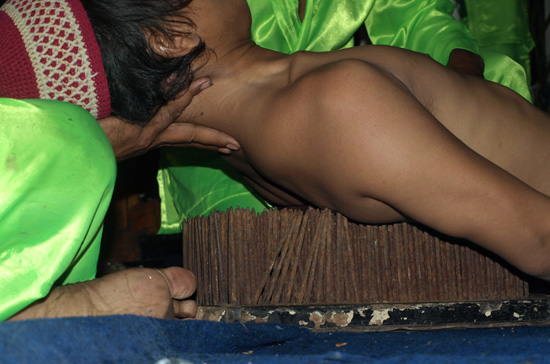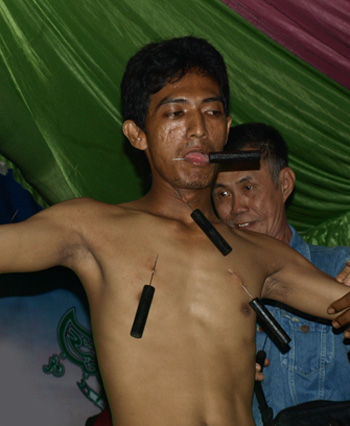In Jakarta’s crowded neighbourhoods, beliefs in supernatural power and invulnerability still surround the figure of the jago tough man
Ian Wilson
Displaying imperviousness to painIan Wilson |
I followed Bang Cep on his nightly rounds of the food stalls surrounding the bus terminal. This was Bang Cep’s territory and he walked with an exaggerated swaggering confidence. Vendors he approached for their ‘protection’ fee greeted him politely, but their eyes betrayed an apprehension bordering on fear. At Pak Dede’s fried tofu stall Bang Cep loudly berated him for his lateness in paying his dues, slamming his ring encrusted hand on the flimsy wooden stall to emphasis the point. Eyes downcast, Pak Dede muttered an apology, promising to pay in full, with interest, the next day.
I returned to Pak Dede’s foodstall later that evening for dinner. Asking him about the encounter with Bang Cep, he let out a pained sigh, ‘Yeah, as you saw that’s what we have to deal with. We don’t like it, but what can we do? People say he is invulnerable, plus he is close to the police. Either way, if it weren’t him it would be someone else. For now at least he is the biggest cock around here, and unless we want to get bashed we do what he says.’
Extortion, intimidation and beatings at the hands of jago – literally a ‘cock’ or ‘rooster’, but colloquially a descriptor for a type of local strongman – constitute an unsavoury aspect of everyday life in urban and rural centres throughout Indonesia. During the New Order the power and longevity of a jago was ultimately dependent upon favourable relationships with the police, military and political elites. In the post-New Order environment, the fragmentation of previous patronage networks, the unravelling of the New Order criminal state together with the peculiar dynamics of decentralised, democratised Indonesia has created more spaces in which jago can thrive. With greater freedom from reliance upon backing or sanction by state elites, many groups have grown substantially, with branches, franchises and networks of supporters spread throughout the city. At the same time however competition between rival groups has increased as the market in ‘protection’ has become more crowded.
Despite associations with criminality, in Indonesian popular culture, the jago is also often romanticised as a champion of the people and an embodiment of the virile and virtuous man, whose acts of violence are motivated by a deep sense of justice, honour and order, one that transcends that of the law and the state. In the world of jago, notions of masculinity, honour and virility are inextricably bound with those of territoriality and the body. A jago’s power, like that of the state, is in large part judged by the extent of his control over his turf – the street, neighbourhood, market or bus terminal where his gang controls the extraction of illegal fees imposed usually on the pretext of offering protection.
Turf, honour and potency
Reputation is perhaps the single most valuable asset of a jago. The defence of one’s honour from perceived insult is inextricably linked to this name and the ability to exert power over turf. The importance of reputation has especially become the case in the context of the private security industry in Jakarta, where a reputation for getting things done and an ability to maintain ‘order’ is crucial to securing contracts in an increasingly competitive market. It is equally crucial, though, in other locations such as markets and bus terminals. Without such a reputation, a jago is no longer a jago, but simply a jago wannabe.
Jago are commonly understood as using violence as both a first and last resort. But for those seeking to make a living as a jago the use of actual physical violence is highly calculated and measured, even when ‘face’ is at stake. Violence is a tool of communication, useful in so far as it helps in the establishment and maintenance of a name and territory. Once this name is consolidated, the necessity to rely upon violence as the central means of maintaining territorial dominance diminishes significantly.
The ‘art’, then, of the jago’s violence, is to find a balance between fear and respect, to balance the necessity of ruthlessly suppressing challenges to his territorial domain and upholding honour, while not going so far as to alienate himself from the immediate community, or unnecessarily antagonise rivals or the police. At the same time they must cultivate relationships with other local power holders, such as officials, the military and business interests. Being a successful ‘career jago’ thus also requires sophisticated diplomatic and negotiating skills, as well as political shrewdness. In the context of decentralised electoral politics this has seen some jago make the transition to elected official, branch leaders of political parties and even into parliament.
Shortcuts to the superhuman
Even in the context of a modern metropolis like Jakarta, belief in the possession of supernatural abilities is often still an important element in the establishment of the jago’s name. These can include a number of fantastic skills such as invisibility, the ability to be in two places at once, mind-reading and hypnotism. The most important of these, however, is ilmu kebal, a term referring to physical invulnerability from weapons such as knives and firearms. Traditionally the pursuit of kebal was achieved after a long period of tutelage and ascetic trials under the direction of a recognised master. But constant tensions over turf boundaries and general volatility that ensues in crowded urban centres such as Jakarta, together with the difficulties in accessing a suitably secluded space has resulted in the emergence of ‘fast track’ methods for achieving it.
Pak Edi, a gang leader in South Jakarta, is the inventor of one such method. As he explains it, ‘The benefit of this method is that you don’t have to be 100 per cent clean. Even if you have been drinking, gambling or playing with women it still works!’ After asking him to explain further, he suggested that I undergo the ‘procedure’. I agreed, but was immediately alarmed as his assistant produced a strange tangle of electric cords and metal plates. Plugging the cord into an electric socket, I was instructed to place my foot on top of one of the plates. Pak Edi held the other plate under his own foot, and immediately his leg began to quiver from the electric current. Tentatively I placed my other foot down on the tile floor earthing the current, sending my limbs into mild spasms as electricity pulsed through my body. While trying to resist the natural urge to let go, Pak Edi firmly grasped my forearms, closed his eyes and muttered a jumbled mantra, a mixture of Arabic, Indonesian and Javanese. After what seemed like an eternity – and with the soles of my foot feeling as if they were about to combust – Pak Edi finally let go and I jerked back into my chair, my arms quivering uncontrollably for several minutes. ‘That’s it!’ he said with a smile. ‘Now you don’t have to worry about being stabbed!’
Like most jago leaders, Pak Edi rejects any suggestion that his group is criminal, insisting that the security and protection they provide to the community from thieves, pickpockets and drug dealers is a valuable service for which they receive modest ‘voluntary contributions’ from local businesses and vendors. This claim is not without foundation. In an area where the police are rarely seen and trusted even less, many daily policing tasks are carried out by groups such as Pak Edi’s. In his early 50s, with a portly frame and persistent smoker’s cough, Pak Edi is respected and feared by younger and more physically fit local men, who commonly refer to him as possessing supernatural power and as being charismatic and authoritative. With his unique ‘modern’ method for achieving ilmu, he draws followers from outside of his neighbourhood in Kebayoran Lama, some from as far away as Surabaya. His reputation for ilmu also helped him to expand his gang’s network (with, what he claimed, was a minimum of conflict) to include branches in other parts of the city. His authority rests not, then, on his physical prowess but upon his political skills and a cultivated mystical aura.
 |
Tests invulnerability atop a bed of nailsIan Wilson |
Fortifying the body in times of crisis
In times of social and political upheaval where fears emerge regarding the maintaining of personal and social boundaries, belief in invulnerability practices continue to resurface as a last line of bodily defence against social breakdown. During the tumultuous period of social and political change surrounding the resignation of Suharto in 1998, popular tabloids filled with advertisements for ‘instant kebal’ through mantra sent via SMS, as well as short course ‘executive packages’ run by jago seeking to profit from uncertainty. Today in Jakarta there are many selling invulnerability, together with an array of other supernatural powers and abilities.
Armed with kebal the body of the jago is fortified against the dangers of external attack, transforming the physical body into a virtual fortress. That kebal has frequently been proven throughout Indonesian history to be a completely ineffective form of physical protection has not diminished faith in its efficiency. During the struggle for independence, belief in invulnerability saw many run head-first to their deaths at the hands of Dutch machine guns. Not infrequently today, there are reports in local news of an invulnerability test gone wrong, such as occurred in Cilingcing in North Jakarta in early 2012 where two young men died after being bathed in sulphuric acid. Yet despite tragedies such as this interest remains high.
Perhaps, then, the enduring power of belief in invulnerability is related less to its practical uses than it is to its centrality to notions of the empowered, potent and masculine body embodied in the figure of the jago. To be kebal is not just to be free from the fear of being stabbed, but rather to achieve a particular kind of autonomy, to be impervious to external threats and, potentially, to be able to exert ones will over others. With this power one can become the biggest cock.
Ian Wilson (i.wilson@murdoch.edu.au) teaches in the Asian Studies and Security and Politics programs at Murdoch University in Western Australia. This article draws on a chapter Ian contributed to Men and Masculinities in Southeast Asia (eds Michele Ford and Lenore Lyons, Routledge 2012).
